Fractional Variation Network for THz Spectrum Denoising without Clean Data
Abstract
:1. Introduction
- (1)
- The most significant difference between the proposed method and the state-of-the-art deep-learning-based methods is that the proposed method can estimate the clean THz spectrum without clean data.
- (2)
- Fractional variation is introduced to the L2 loss function, which can improve the restored quality and avoid the failure of the L2 loss function.
- (3)
- To estimate the high-quality THz spectrum, the Transformer network is applied, and it is modified to a multi-stream feature fusion network to remove the noise of the THz spectrum. Notably, the Transformer network is a potent natural language processing architecture.
- (4)
- To augment the training data, a low-quality underwater image is applied. Transfer learning is used to prevent signal offset of the low-quality image.
- (5)
- The synthesized data, measured THz spectrum, and THz imaging are utilized to verify the performance of the proposed methods.
2. Methods
2.1. THz Spectra Line Type
2.2. Transfer Learning
2.3. Loss Function with Fractional Order Differential
2.4. Transformer
3. Experiments
3.1. Training Dataset and Detail
3.2. Pre-Train Image
3.3. Simulation Experiment
3.4. Real THz Spectrum
3.5. Data Augmentation Experiment
3.6. Fractional-Order Loss Function
3.7. Application for THz Imaging
4. Conclusions and Prospects
Author Contributions
Funding
Institutional Review Board Statement
Informed Consent Statement
Data Availability Statement
Acknowledgments
Conflicts of Interest
References
- Ferguson, B.; Zhang, X.C. Materials for terahertz science and technology. Nat. Mater. 2002, 1, 26–33. [Google Scholar] [CrossRef] [PubMed]
- Chen, H.T.; Padilla, W.J.; Zide, J.M.O.; Gossard, A.C.; Taylor, A.J.; Averitt, R.D. Active terahertz metamaterial devices. Nature 2006, 444, 597–600. [Google Scholar] [CrossRef] [PubMed] [Green Version]
- Zhang, M.J.; Hong, H.C.; Lin, H.J.; Shen, L.G.; Yu, H.Y.; Ma, G.C.; Chen, J.R.; Liao, B.Q. Mechanistic insights into alginate fouling caused by calcium ions based on terahertz time-domain spectra analyses and DFT calculations. Water Res. 2018, 129, 337–346. [Google Scholar] [CrossRef] [PubMed]
- Naftaly, M.; Vieweg, N.; Deninger, A. Industrial applications of terahertz sensing: State of play. Sensors 2019, 19, 4203. [Google Scholar] [CrossRef] [Green Version]
- Son, J.H.; Oh, S.J.; Cheon, H. Potential clinical applications of terahertz radiation. J. Appl. Phys. 2019, 125, 190901. [Google Scholar] [CrossRef]
- Ahmed, K.; Ahmed, F.; Roy, S.; Paul, B.K.; Aktar, M.N.; Vigneswaran, D.; Islam, M.S. Refractive index-based blood components sensing in terahertz spectrum. IEEE Sens. J. 2019, 19, 3368–3375. [Google Scholar] [CrossRef]
- Guo, Y.X.; Jin, W.Q.; Guo, Z.Y.; He, Y.Q. Iterative differential autoregressive spectrum estimation for Raman spectrum denoising. J. Raman. Spectrosc. 2022, 531, 148–165. [Google Scholar] [CrossRef]
- Naftaly, M. Metrology issues and solutions in THz time-Domain spectroscopy: Noise, errors, calibration. IEEE Sens. J. 2013, 13, 8–17. [Google Scholar] [CrossRef]
- Skorobogatiy, M.; Sadasivan, J.; Guerboukha, H. Statistical models for averaging of the pump-probe traces: Example of denoising in terahertz time-domain spectroscopy. IEEE Trans. Terahertz Sci. Technol. 2018, 8, 287–298. [Google Scholar] [CrossRef]
- Pupeza, I.; Wilk, R.; Koch, M. Highly accurate optical material parameter determination with THz time-domain spectroscopy. Opt. Express 2007, 15, 4335–4350. [Google Scholar] [CrossRef]
- Shen, S.; He, J. SGCS: A signal reconstruction method based on Savitzky-Golaysgz filtering and compressed sensing for wavelength modulation spectroscopy. Opt. Express 2021, 29, 35848–35863. [Google Scholar] [CrossRef] [PubMed]
- Khani, M.E.; Arbab, M.H. Chemical identification in the specular and off-specular rough-surface scattered Terahertz spectra using wavelet shrinkage. IEEE Access 2021, 9, 29746–29754. [Google Scholar] [CrossRef] [PubMed]
- Zeng, X.X.; Zhang, H.; Xi, X.Q.; Li, B.; Zhou, J. Numerically denoising thermally tunable and thickness-dependent terahertz signals in ErFeO3 based on bézier curves and B-Splines. Ann. Phys. 2021, 533, 2000464. [Google Scholar] [CrossRef]
- Wang, S.; Niu, P.J.; Guo, Q.H.; Wang, X.C.; Wang, F.Z. An adaptive empirical mode decomposition and stochastic resonance system in high efficient detection of terahertz radar signal. Ferroelectrics 2020, 536, 148–160. [Google Scholar] [CrossRef]
- Liu, H.; Li, Y.; Zhang, Z.; Liu, S.; Liu, T. Blind Poissonian reconstruction algorithm via curvelet regularization for FTIR spectrometer. Opt. Express 2018, 26, 22837–22856. [Google Scholar] [CrossRef]
- Chen, X.; Sun, Q.; Stantchev, R.I.; Pickwell-MacPherson, E. Objective and efficient terahertz signal denoising by transfer function reconstruction. APL Photonics 2020, 5, 056104. [Google Scholar] [CrossRef]
- Yann, L.C.; Yoshua, B.; Geoffrey, H. Deep learning. Nature 2015, 521, 436–444. [Google Scholar]
- Hou, C.P.; Nie, F.P.; Li, X.L.; Yi, D.Y.; Wu, Y. Joint embedding learning and sparse regression: A framework for unsupervised feature selection. IEEE Trans. Cybern. 2014, 44, 793–804. [Google Scholar]
- Hui, M.; Wu, Y.; Li, W.; Liu, M.; Dong, L.; Kong, L.; Zhao, Y. Image restoration for synthetic aperture systems with a non-blind deconvolution algorithm via a deep convolutional neural network. Opt. Express 2020, 28, 9929–9943. [Google Scholar] [CrossRef]
- Liu, W.; Zhao, Y.; Liu, M.; Yi, W.; Dong, L.; Hui, M. Triple-adjacent-frame generative network for blind video motion deblurring. Neurocomputing 2020, 376, 153–165. [Google Scholar] [CrossRef]
- Zhang, K.; Zuo, W.M.; Chen, Y.J.; Meng, D.Y.; Zhang, L. Beyond a Gaussian denoiser: Rresidual learning of deep CNN for image denoising. IEEE Trans. Image Process. 2017, 26, 3142–3155. [Google Scholar] [CrossRef] [PubMed] [Green Version]
- Pan, L.; Pipitsunthonsan, P.; Zhang, P.; Daengngam, C.; Booranawong, A.; Chongcheawchamnan, M. Noise reduction technique for Raman spectrum using deep learning network. In Proceedings of the 13th International Symposium on Computational Intelligence and Design, Hangzhou, China, 12–13 December 2020; pp. 159–163. [Google Scholar]
- Wahl, J.; Sjödahl, M.; Ramser, K. Single-Step Preprocessing of Raman Spectra Using Convolutional Neural Networks. Appl. Spectrosc. 2020, 74, 427–438. [Google Scholar] [CrossRef] [PubMed]
- Jiao, Q.L.; Liu, M.; Yu, K.; Liu, Z.L.; Kong, L.Q.; Hui, M.; Dong, L.Q.; Zhao, Y.J. Spectral Pre-Processing Based on Convolutional Neural Network. Spectrosc. Spectr. Anal. 2022, 42, 292–297. [Google Scholar]
- Zhang, Q.; Yang, L.T.; Chen, Z.; Li, P. A survey on deep learning for big data. Inform. Fusion. 2018, 42, 146–157. [Google Scholar] [CrossRef]
- Jeong, S.Y.; Cheon, H.; Lee, D.; Son, J.H. Determining terahertz resonant peaks of biomolecules in aqueous environment. Opt. Express 2020, 28, 3854–3863. [Google Scholar] [CrossRef]
- Ferrer-Galindo, L.; Sanu-Ginarte, A.D.; Fleitas-Salazar, N.; Ferrer-Moreno, L.A.; Rosas, R.A.; Pedroza-Montero, M.; Riera, R. Denoising and principal component analysis of amplified Raman spectra from red blood cells with added silver nanoparticles. J. Nanomater. 2018, 2018, 9417819. [Google Scholar] [CrossRef]
- El Haddad, J.; Bousquet, B.; Canioni, L.; Mounaix, P. Review in terahertz spectral analysis. TrAC-Trend Anal. Chem. 2013, 44, 98–105. [Google Scholar] [CrossRef] [Green Version]
- Qiao, L.; Wang, Y.; Zhao, Z.; Chen, Z. Identification and quantitative analysis of chemical compounds based on multiscale linear fitting of terahertz spectra. Opt. Eng. 2014, 53, 074102. [Google Scholar] [CrossRef]
- Haslauer, K.; Schmitt-Kopplin, P.; Heinzmann, S. Data processing optimization in untargeted metabolomics of urine using Voigt lineshape model non-linear regression analysis. Metabolites 2021, 11, 285. [Google Scholar] [CrossRef]
- Zhuang, F.; Qi, Z.; Duan, K.; Xi, D.; Zhu, Y.; Zhu, H.; Xiong, H.; He, Q. A comprehensive survey on transfer learning. Proc. IEEE 2021, 109, 43–76. [Google Scholar] [CrossRef]
- Jiao, Q.; Liu, M.; Li, P.; Dong, L.; Hui, M.; Kong, L.; Zhao, Y. Underwater image restoration via non-convex non-smooth variation and thermal exchange optimization. J. Mar. Sci. Eng. 2021, 9, 570. [Google Scholar] [CrossRef]
- Jaakko, L.; Jacob, M.; Jon, H.; Samuli, L.; Tero, K.; Miika, A.; Timo, A. Noise2Noise: Learning Image Restoration without Clean Data. arXiv 2018, arXiv:1803.04189. [Google Scholar]
- Zhang, X.; Li, D.Q.; Li, J.; Liu, B.; Jiang, Q.Y.; Wang, J.H. Signal-Noise Identification for Wide Field Electromagnetic Method Data Using Multi-Domain Features and IGWO-SVM. Fractal Fract. 2022, 6, 80. [Google Scholar] [CrossRef]
- Stoica, R.-A.; Iimori, H.; de Abreu, G.T.F.; Ishibashi, K. Frame Theory and Fractional Programming for Sparse Recovery-Based mmWave Channel Estimation. IEEE Access 2019, 7, 150757–150774. [Google Scholar] [CrossRef]
- Yang, Q.; Chen, D.; Zhao, T.; Chen, Y. Fractional Calculus in Image Processing: A Review. Fract. Calc. Appl. Anal. 2016, 19, 1222–1249. [Google Scholar] [CrossRef] [Green Version]
- Zhang, X.; Dai, L. Image Enhancement Based on Rough Set and Fractional Order Differentiator. Fractal Fract. 2022, 6, 212. [Google Scholar] [CrossRef]
- Vaswani, A.; Shazeer, N.; Parmar, N.; Uszkoreit, J.; Jones, L.; Gomez, A.N.; Kaiser, L.; Polosukhin, I. Attention Is All You Need. arXiv 2017, arXiv:1706.03762. [Google Scholar]
- Fan, H.; Xiong, B.; Mangalam, K.; Li, Y.; Yan, Z.; Malik, J.; Feichtenhofer, C. Multiscale Vision Transformers. arXiv 2021, arXiv:2104.11227. [Google Scholar]
- Hou, Y.; Xu, J.; Liu, M.; Liu, G.; Liu, L.; Zhu, F.; Shao, L. NLH: A Blind Pixel-Level Non-Local Method for Real-World Image Denoising. IEEE Trans. Image Process. 2020, 29, 5121–5135. [Google Scholar] [CrossRef] [Green Version]
- Yu, K.; Cheng, Y.F.; Li, L.F.; Zhang, K.H.; Liu, Y.L.; Liu, Y.F. Underwater Image Restoration via DCP and Yin–Yang Pair Optimization. J. Mar. Sci. Eng. 2022, 10, 360. [Google Scholar] [CrossRef]
- Linstrom, P.J.; Mallard, W.G. NIST Chemistry WebBook, NIST Standard Reference Database Number 69; National Institute of Standards and Testing (NIST): Gaithersburg, MD, USA, 2013. [Google Scholar]
- Available online: https://figshare.com/ (accessed on 26 June 2019).
- Liu, H.; Zhang, Z.L.; Liu, S.Y.; Yan, L.X.; Liu, T.T.; Zhang, T.X. Joint Baseline-Correction and Denoising for Raman Spectra. Appl. Spectrosc. 2015, 69, 1013–1022. [Google Scholar] [CrossRef] [PubMed]
- Djarfour, N.; Ferahtia, J.; Babaia, F.; Baddari, K.; Said, E.; Farfour, M. Seismic noise filtering based on Generalized Regression Neural Networks. Comput. Geosci. 2014, 69, 1–9. [Google Scholar] [CrossRef]
- Sun, X.; Liu, J.; Zhu, K.; Hu, J.; Jiang, X.; Liu, Y. Generalized regression neural network association with terahertz spectroscopy for quantitative analysis of benzoic acid additive in wheat flour. R. Soc. Open Sci. 2019, 7, 190485. [Google Scholar] [CrossRef] [PubMed] [Green Version]
- Cheng, G.; Zhou, P.; Han, J. Learning Rotation-Invariant Convolutional Neural Networks for Object Detection in VHR Optical Remote Sensing Images. IEEE Trans. Geosci. Remote Sens. 2016, 54, 7405–7415. [Google Scholar] [CrossRef]
- Wong, T.M.; Kahl, M.; Bolívar, P.H.; Kolb, A.; Möller, M. Training Auto-enconder-Based Optimizers for Terahertz Image Reconstruction. In Proceedings of the 2019 German Conference on Pattern Recognition, Dortmund, Germany, 10–13 September 2019; pp. 93–106. [Google Scholar]
- Mittal, A.; Moorthy, A.K.; Bovik, A. No-Reference Image Quality Assessment in the Spatial Domain. IEEE Trans. Image Process. 2012, 21, 4695–4708. [Google Scholar] [CrossRef] [PubMed]
- Mittal, A.; Rajiv, S.; Bovik, A.C. Making a “Completely Blind” Image Quality Analyzer. IEEE Signal Proc. Lett. 2012, 20, 209–212. [Google Scholar] [CrossRef]


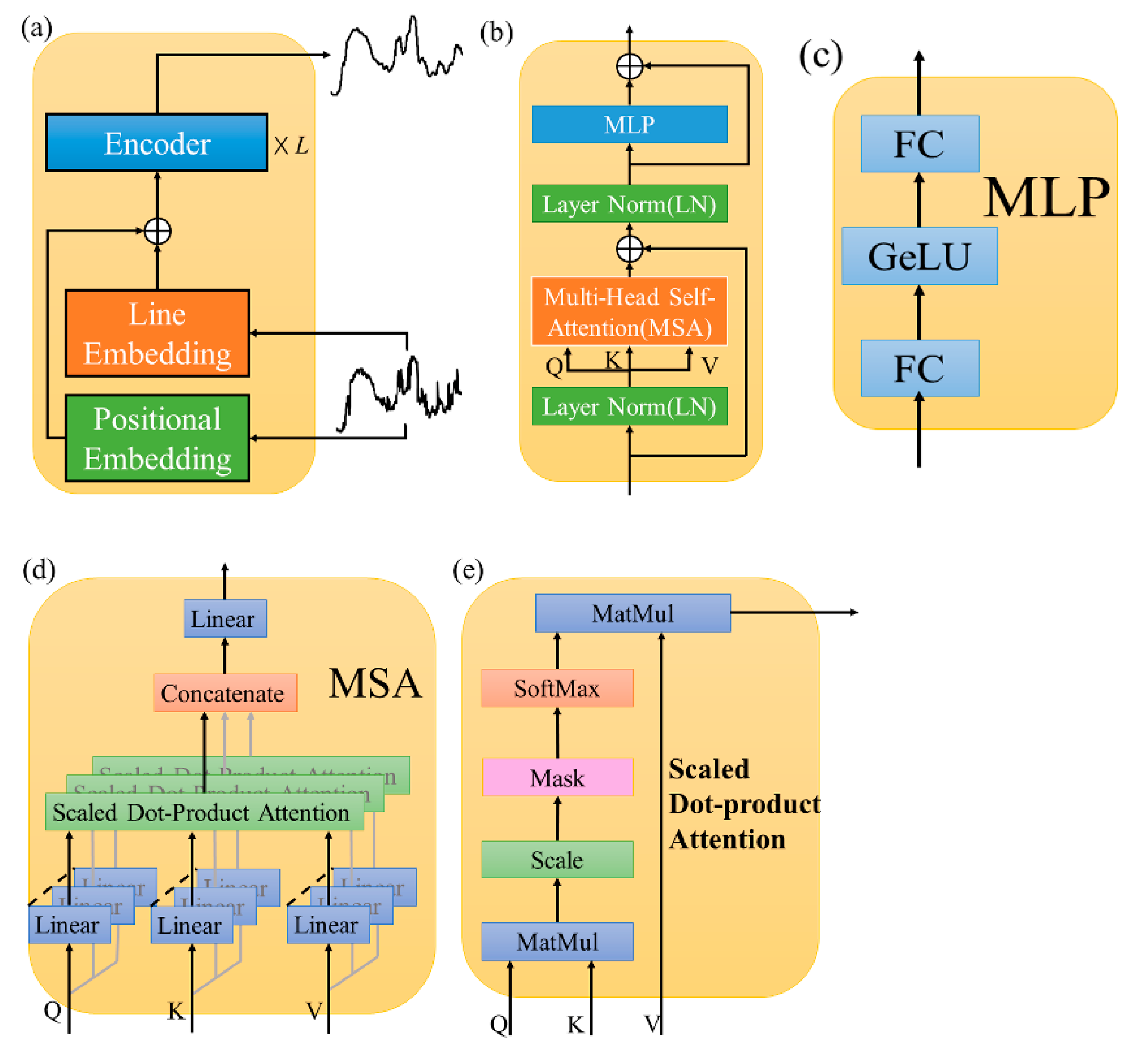
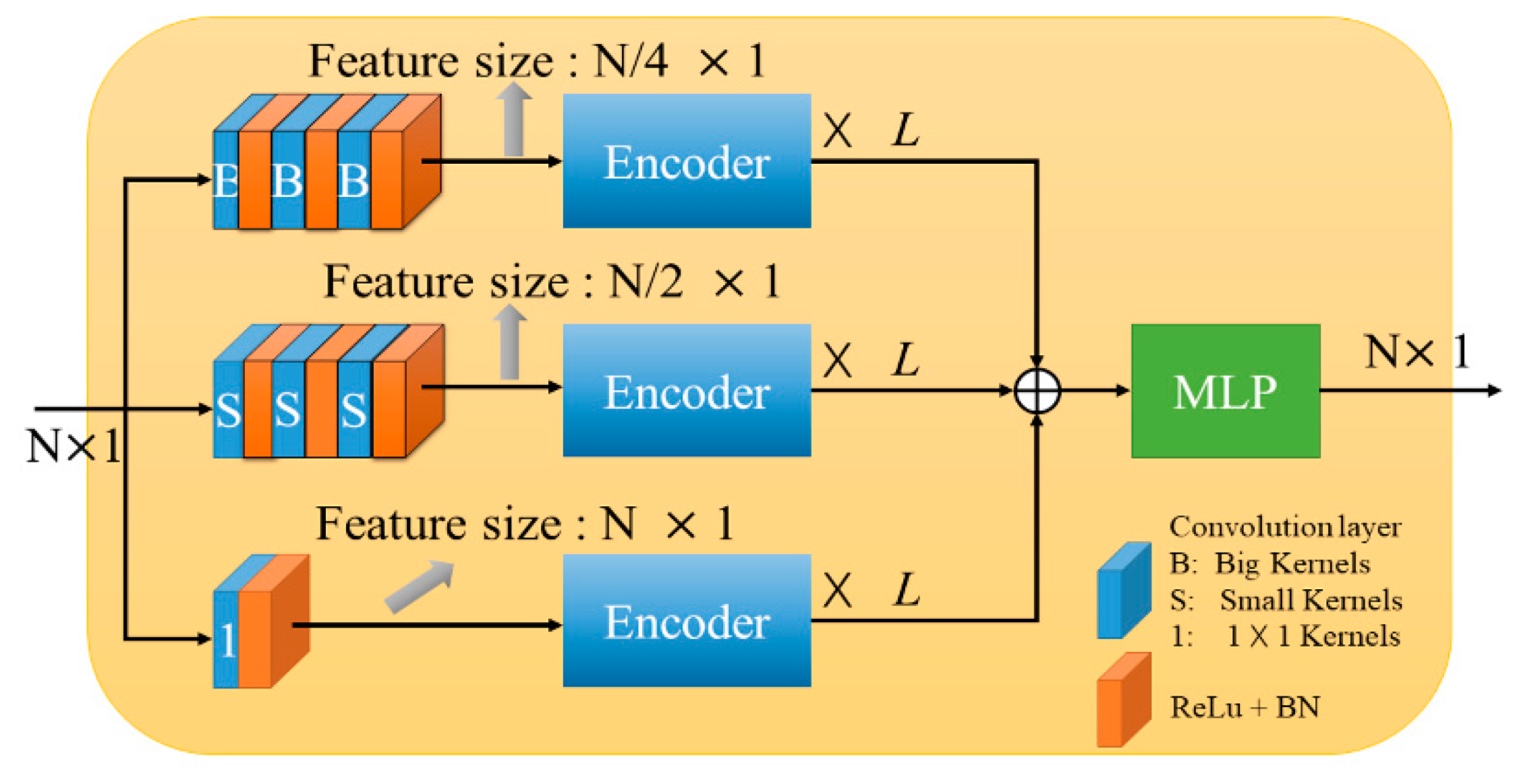



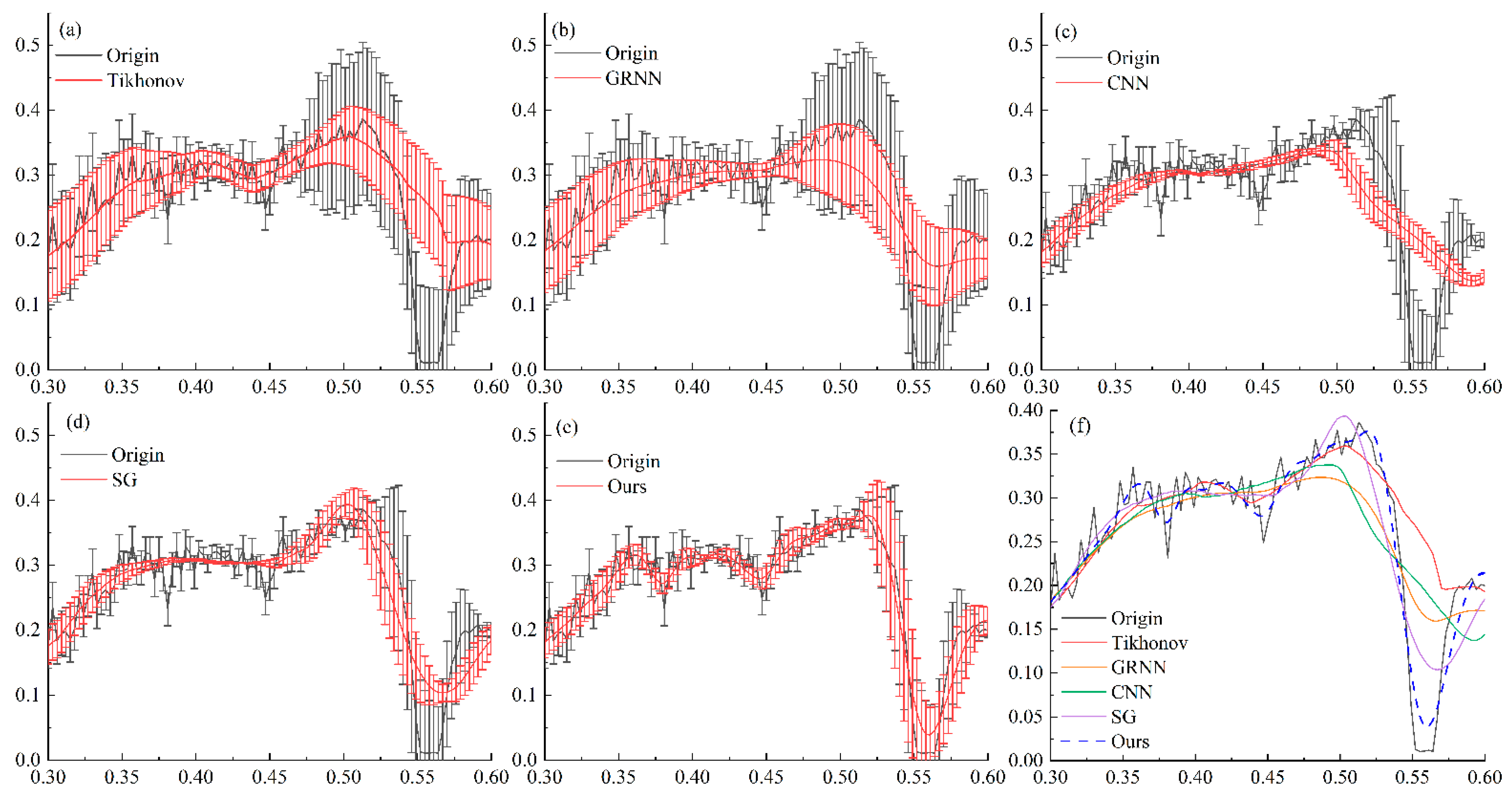
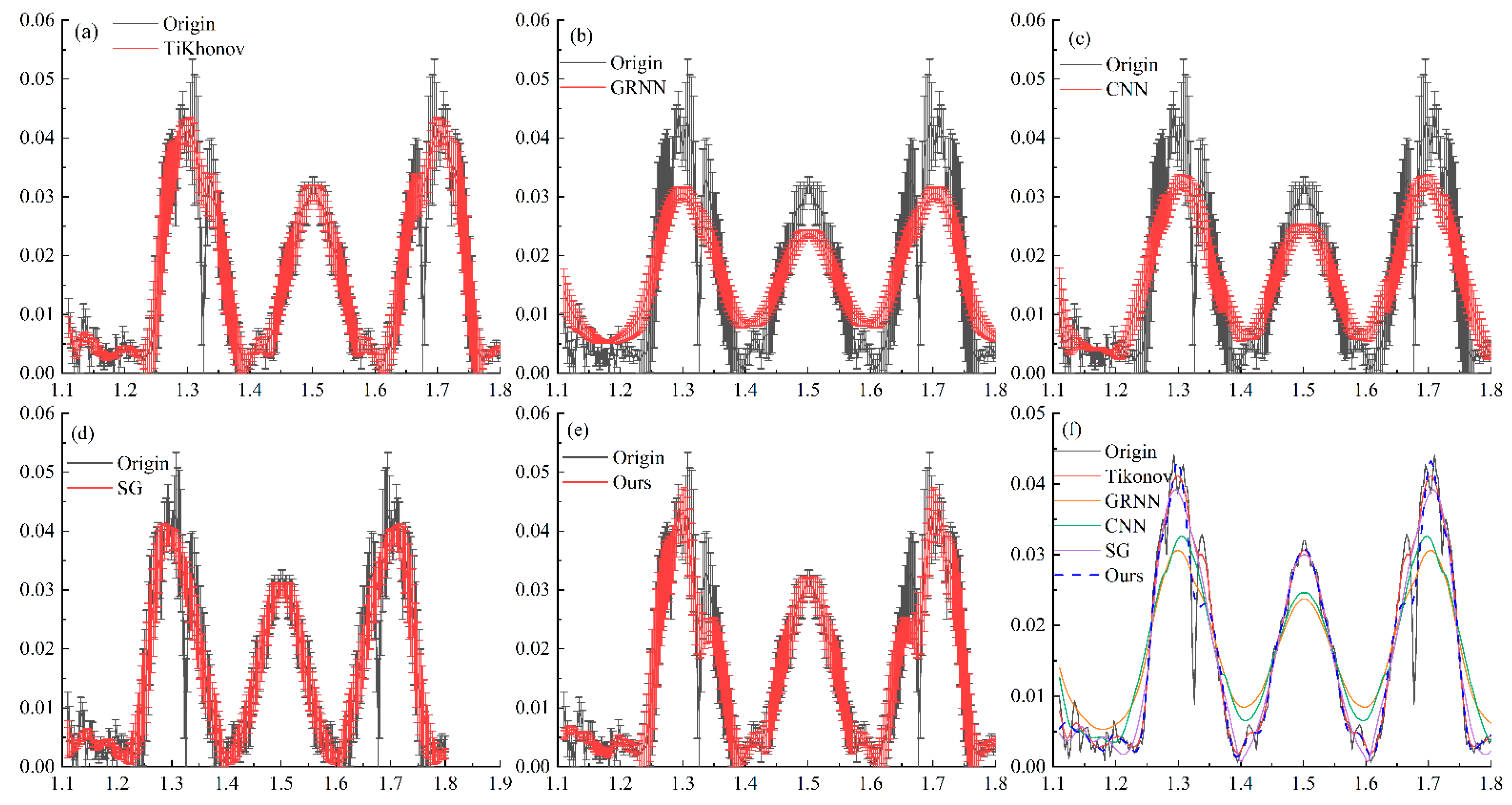


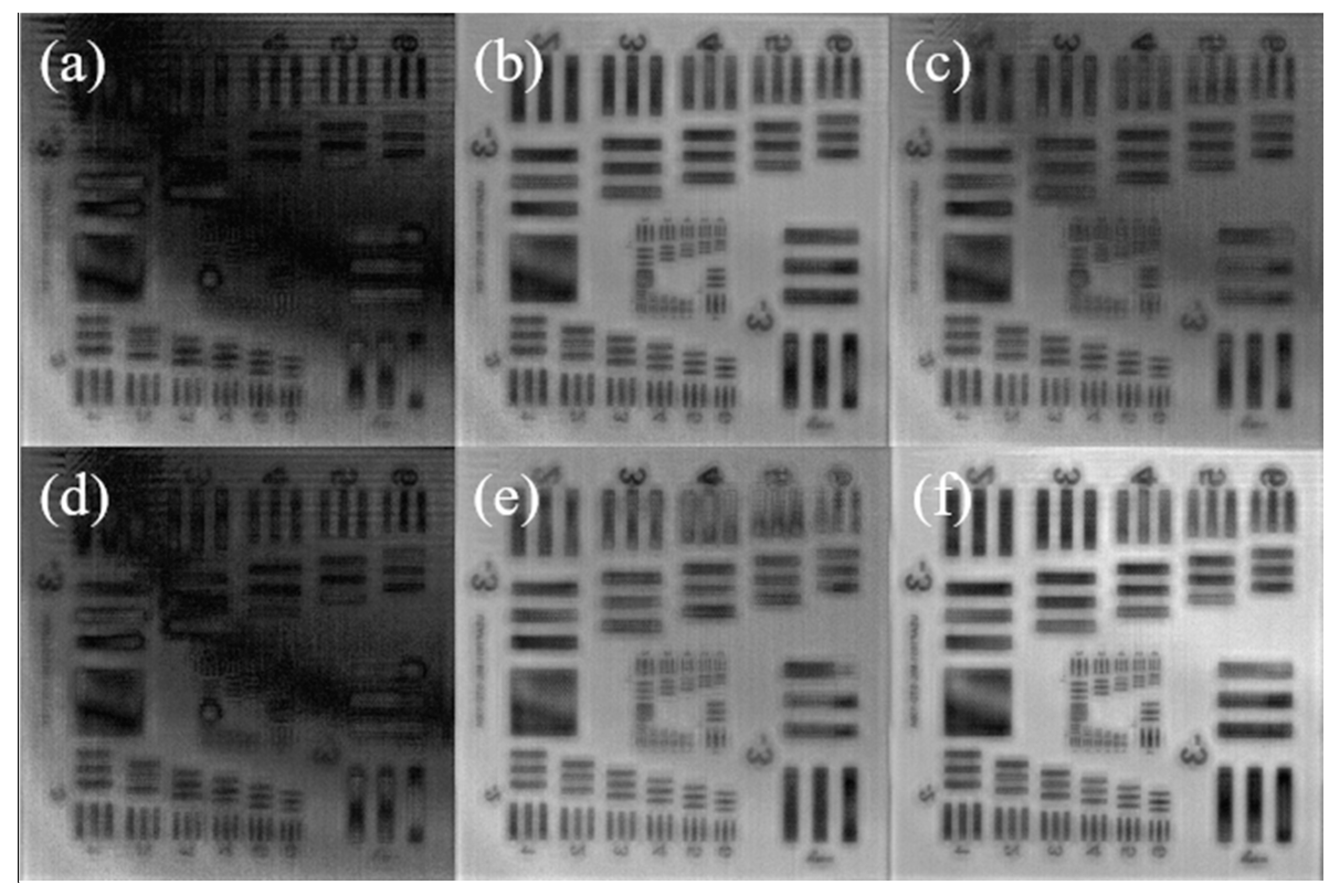

| SSIM | Absolute Value of R2 | p (α = 0.05) | ||||
|---|---|---|---|---|---|---|
| Mean | Median | Mean | Median | Mean | Median | |
| Underwater images | 0.3697 | 0.3753 | 0.2764 | 0.2330 | 0.0344 | <0.0001 |
| Natural images | 0.3344 | 0.3578 | 0.2385 | 0.1961 | 0.0665 | <0.0001 |
| Nighttime images | 0.2713 | 0.2533 | 0.1894 | 0.1627 | 0.0354 | <0.0001 |
| R2 | RMSE | SNR/dB | |
|---|---|---|---|
| Underwater images | 0.794 | 0.071 | 13.125 |
| Natural images | 0.631 | 0.137 | 9.644 |
| Nighttime images | 0.759 | 0.083 | 11.739 |
| Peak ID | Standard | Tikhonov | GRNN | CNN | SG | Ours | |
|---|---|---|---|---|---|---|---|
| 1 | Position | 35 | 35.2 | 34.4 | 35.4 | 34.2 | 34.6 |
| Intensity | 0.7 | 0.707 | 0.6713 | 0.693 | 0.689 | 0.697 | |
| 2 | Position | 79 | 78 | 79.6 | 77.8 | 79.2 | 79 |
| Intensity | 0.616 | 0.495 | 0.507 | 0.398 | 0.568 | 0.620 | |
| 3 | Position | 90.6 | 93.2 | 89.6 | 84.2 | 93.2 | 90.2 |
| Intensity | 0.874 | 0.518 | 0.635 | 0.410 | 0.419 | 0.873 | |
| 4 | Position | 108 | 108.4 | 107.8 | 108.2 | 108.2 | 108 |
| Intensity | 0.86 | 0.863 | 0.833 | 0.851 | 0.853 | 0.861 | |
| 5 | Position | 185 | 184.6 | 186.6 | 184.8 | 184.4 | 184.8 |
| Intensity | 0.71 | 0.705 | 0.686 | 0.698 | 0.699 | 0.708 |
Publisher’s Note: MDPI stays neutral with regard to jurisdictional claims in published maps and institutional affiliations. |
© 2022 by the authors. Licensee MDPI, Basel, Switzerland. This article is an open access article distributed under the terms and conditions of the Creative Commons Attribution (CC BY) license (https://creativecommons.org/licenses/by/4.0/).
Share and Cite
Jiao, Q.; Xu, J.; Liu, M.; Zhao, F.; Dong, L.; Hui, M.; Kong, L.; Zhao, Y. Fractional Variation Network for THz Spectrum Denoising without Clean Data. Fractal Fract. 2022, 6, 246. https://doi.org/10.3390/fractalfract6050246
Jiao Q, Xu J, Liu M, Zhao F, Dong L, Hui M, Kong L, Zhao Y. Fractional Variation Network for THz Spectrum Denoising without Clean Data. Fractal and Fractional. 2022; 6(5):246. https://doi.org/10.3390/fractalfract6050246
Chicago/Turabian StyleJiao, Qingliang, Jing Xu, Ming Liu, Fengfeng Zhao, Liquan Dong, Mei Hui, Lingqin Kong, and Yuejin Zhao. 2022. "Fractional Variation Network for THz Spectrum Denoising without Clean Data" Fractal and Fractional 6, no. 5: 246. https://doi.org/10.3390/fractalfract6050246
APA StyleJiao, Q., Xu, J., Liu, M., Zhao, F., Dong, L., Hui, M., Kong, L., & Zhao, Y. (2022). Fractional Variation Network for THz Spectrum Denoising without Clean Data. Fractal and Fractional, 6(5), 246. https://doi.org/10.3390/fractalfract6050246









